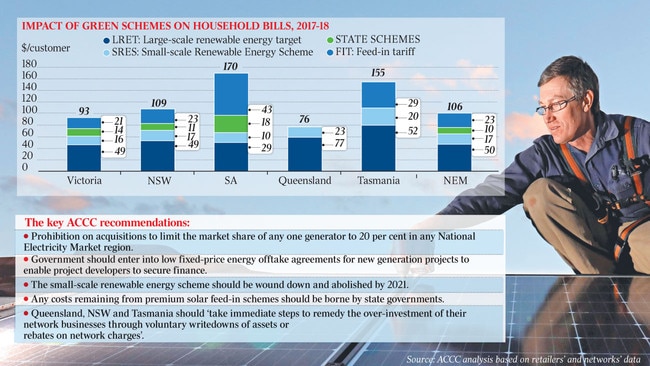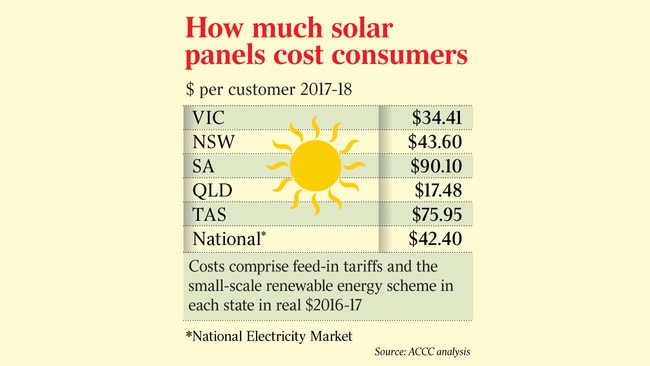Rooftop solar deals should be axed, says regulator
Rooftop solar subsidies should be axed and the states should take on the cost of solar feed-in tariffs, the ACCC says.

Rooftop solar subsidies should be axed and the states should take on the cost of “excessively generous” solar feed-in tariffs to ease the burden of green power schemes that cost households up to $170 a year, the competition watchdog has recommended.
The Australian Competition & Consumer Commission’s electricity affordability report reveals the huge cost of environmental schemes across the National Energy Market, including the large-scale renewable energy target, the small-scale renewable energy scheme and solar feed-in tariffs.
The schemes add a combined $170 to household energy bills in South Australia, $155 in Tasmania, $109 in NSW, $93 in Victoria and $76 in Queensland.
Subsidies for home solar, through the small-scale scheme and premium feed-in tariffs, cost households an average $42.40 a year.
The ACCC said government incentives led to a spike in rooftop solar installations that “exceeded all expectations”, lifting the proportion of households with solar from just 0.2 per cent in 2007-08, to more than 12 per cent in 2017-18.
It said households with rooftop solar panels reaped an average $538 a year from feeding energy into the grid, on top of savings from reduced electricity use.
“Meanwhile, non-solar households and businesses have faced the burden of the cost of premium solar feed-in tariff schemes and the SRES,” the ACCC said.
“While premium solar schemes are closed to new consumers, the costs of these schemes are enduring.”

The ACCC said the large-scale renewable energy subsidies had “distorted” investment towards wind and solar plants “in a way that was indifferent to the ability to provide energy to the market when demand requires it”.
Malcolm Turnbull also attacked the Labor-designed renewable energy target, saying it had “ignored reliability and the importance of dispatchable power”.
The ACCC said the costs associated with the LRET were expected to fall significantly after 2020, and did not recommend any action to wind up the scheme before its 2030 end date. But it said the SRES, which cost $130 million in 2016-17, should be wound down and abolished by 2021, almost a decade ahead of schedule, to reduce costs for consumers.
“In light of the dramatic reduction in solar PV installation costs, the ACCC considers the case for a subsidy for small-scale solar installations is now weak, and is of the view that the SRES should be ended earlier than its currently scheduled end date in 2030,” the report said.
“Removing the SRES would save an average residential customer in the NEM $15-$30 per year depending on state.”
The competition watchdog was critical of the premium solar feed-in schemes offered by the states in which “the subsidy paid to consumers for the energy produced by their systems outweighed, by many multiples, the value of that energy”.
It said state governments should shoulder the costs of schemes, as the Queensland government had done in 2017 at a cost of $771m over three years. If the Queensland policy was implemented more broadly, it would save households $19 a year in Victoria, $25 in NSW, $45 in Tasmania and $72 in South Australia.
The solar industry called for the government to rule out ending the SRES, saying it would deprive households and businesses of their only means of lowering their power bills.
“It’s up to the Turnbull government to come out and reject this attack on solar,” Smart Energy Council CEO John Grimes said. “Not only does this government want to stop new big solar farms, it wants to stop families taking charge of their power bills with rooftop solar.”
Western Sydney Solar owner Rod Grono said he was worried that abolishing the rooftop solar subsidy would lead to a plunge in solar installations.
“Confidence will fall. For a $10,000, 5.2kW job, (small-scale technology certificates) are about $3300. That means a four-year payback becomes a seven or eight-year payback. That might tip people over,” Mr Grono said.
He said the government should incentivise panels on western, sunset-facing roofs to help with the afternoon peak. It should also subsidise battery storage, Mr Grono said. Clean Energy Council chief executive Kane Thornton said the “modest support” under the SRES had enabled the installation of rooftop solar power on almost two million homes.
He said the scheme was also linked to the solar industry accreditation scheme, ensuring safe, high-quality installations. He urged the government to exercise caution “to ensure it does not damage investment confidence that is crucial to bringing on new power supply”.
The ACCC said the SRES was designed to support solar installations when solar PV costs were far higher than today. An average 1.5kW system cost about $18,000 in 2007, while a 3kW system costs about $5000 today. Modelling suggested the SRES would fund about 32 per cent of the cost of a 5kW system by 2020.


